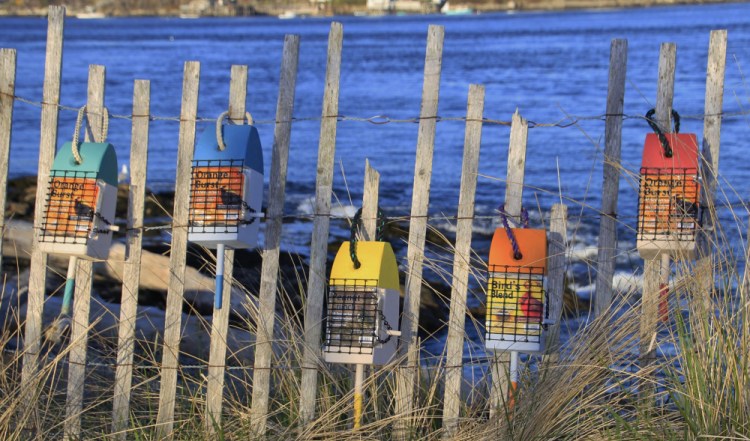Get ready for spring migrants with a lobster buoy suet feeder made from recycled materials at the Lobster Buoy Birdhouse Company in Bowdoinham.
Peter and Nikki Sullivan, owners of the company, retired to Maine from Alaska 10 years ago. They built a house and a barn on their 60 acres of land, and even got a few animals. Then came the recession, and they started looking for part-time opportunities to replenish their bank account. Working out of a stall in their barn, they began by making lobster buoy birdhouses. But a suet feeder they added to their line soon became their most popular product.
The feeders are made of “leftover” rough-cut Maine cedar purchased from a furniture-and-fence maker. “It’s three times as expensive as pine, but it lasts so much longer,” Peter Sullivan said.
The Sullivans realized that when they cut out the center of a birdhouse, they got a smaller version of a lobster buoy. That extra wood became the suet feeder, protected with a stain coating to add to the rustic look. The feeders are tied to trees using recycled lobster rope.
“We wanted it to look like you had found it on the beach,” Nikki Sullivan said.
At first, the Sullivans gathered the lobster rope themselves during winter beach walks. But as their company grew, they needed a lot more rope. So they drove along the coast, stopping at wharves to ask lobstermen for their old rope. Sometimes they’d trade a lobster buoy birdhouse for a bunch of rope.
“It’s stuff that was going to get thrown away and go to the dump, so they don’t mind us taking it off their hands,” Peter Sullivan said. (Once they found a whole winter’s worth of rope in a recycling facility in Georgetown, where a lot of lobstermen live.)
The feeders attract all kinds of woodpeckers, nuthatches, chickadees and titmice. They’re $26 plus shipping on lobsterbuoybirdhouse.com and $36 in retail stores. For a list of stores that carry them, visit the website.
Send questions/comments to the editors.




Comments are no longer available on this story